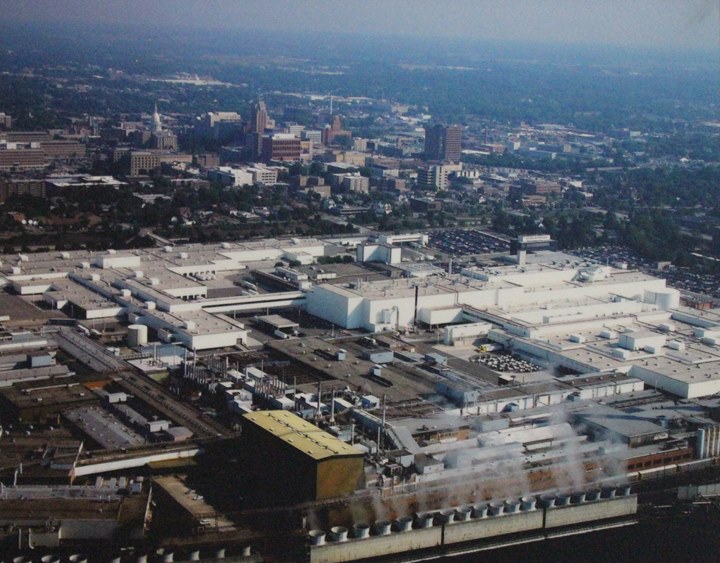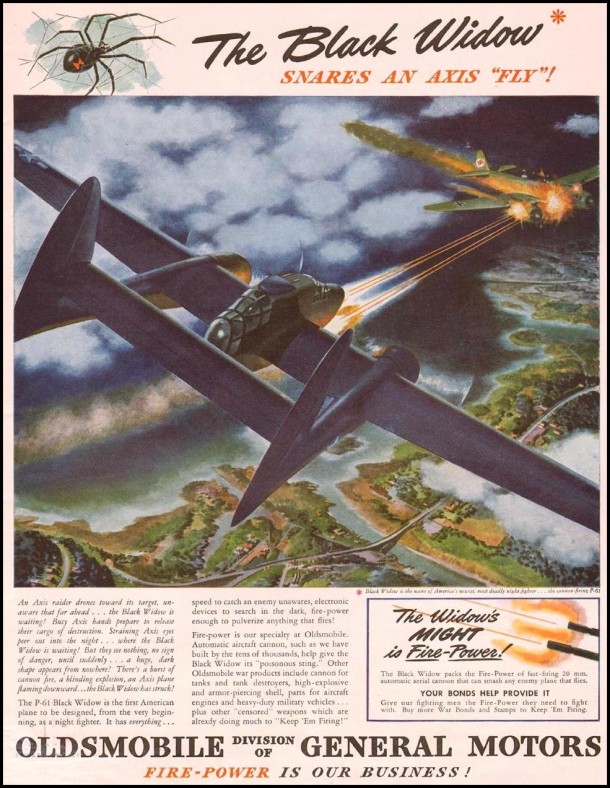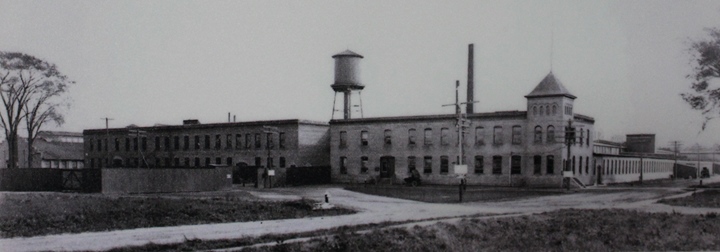
After the United States entered World War Two there was a desperate need to manufacture weapons of war. Along with the planes, tanks, and guns, ammunition and fuel were needed to utilize these weapons. The Big Three car manufacturers played a huge role with the manufacturing of these weapons. Automobile factories across Michigan and the United States of America were converted into factories to produce planes, guns, tanks, and ammunition. The early years of the war were a tough road for the auto manufactures. Ramping up production to meet wartime.
The goal of 500,000 machine guns per year was particularly ambitious because machine gun production in 1941 was only 77,151
Arsenal Of Democracy [5]
Within a few years Oldsmobile, and the other auto manufacturers were able to exponentially increase production of their factories. By the end of World War II, the United States of America had about forty two percent of the world’s manufacturing capacity. Only six years earlier the United States had about thirty two percent of the world’s manufacturing capacity [5]. This Oldsmobile factory in Lansing focused on making cannons and ammunition.
Ammunition
The Lansing Assembly Plant is located in Lansing on Townsend St, just north of the Grand River. Oldsmobile’s moto during World War II was “Keep ‘Em Firing” and “Fire-Power is Our Business” [2]. This was plastered on all their motivational posters around the factories. The drive to produce weapons, ammunition, and parts for the war effort was shared across all workers in all automotive factories across Michigan.
Great holes are chopped in concrete floors to provide anchorage for machines big enough to be used in making four-motored bombers and sixty-ton tanks. New machines start whirring even before they have been fully bolted to the floor. Old machines are hauled to repair shops and, whenever possible, adapted to war use
Clive [7]

The need for production of war machines was known across the United States. To improve production, Oldsmobile insisted on the importance of everyone putting an effort towards the war, often treating workers not as workers, but as soldiers. The need for ammunition was critical for the war effort.
All these heavy weapons would have been the proverbial screen-door-on-a-submarine-useless unless tons of ammunition could be produced to slam into their hot, hungry breeches
Donelly [6]
Oldsmobile was the main producer of gun and ammunition for the General Motors Corporation and the Lansing Assembly Plant was the biggest plant in the United States for cannon ammunition. The Lansing Oldsmobile plant was able to produce cannon ammunition quite well, about 21 million cannon shells from 1942 to 1945, this was about half of the shells and projectiles produced from the three Oldsmobile plants across the United States of America [4]. Oldsmobile was able to produce so many shells by using a new technique. The technique was to forge the rough shape of the shell, and then extrude the hot forging through dies to get the net final shape. The most unbelievable part of it was that Oldsmobile was able to get extremely tight tolerances and surface finish, to a point where minimal machining post-processing was needed for the final product [1].
Oldsmobile forges shell bodies to final dimensions by the upsetting method, which embraces a series of six dies arranged in a vertical bank. The first upsets and pierces the center. The remaining five shape shell and cavity to size. When shells are forged by this method machining is held to a minimum
Plant Tour Guide Book of Oldsmobile during WWII [1]
This forging and extruding process was only capable because of the new forge that the Lansing plant had recently built [2]. This forge also opened up many different contract opportunities.
Detroit isn’t worrying about tomorrow, mister. The boys in the Pacific are yelling for help today. Detroit’s worries are right now
The Arsenal Of Democracy FDR, Detroit, and an Epic Quest to Arm an America at War
Weapons

Along with cannon shells, the plants also produced the cannons as well. The cannons produced were used in tanks, fighter planes, bombers, and naval ships [4]. Within a year of manufacturing, the Lansing Assembly Plant had produced over ten thousand cannons for the war effort [5]. The weapons and ammunition produced in the plant were used around the world. Oldsmobile was contracted to assemble cannons and ammunition from several different companies. Oldsmobile was under contract for Colt to manufacture the M2 Cannon, and later the M4 Autocannon [4]. Oldsmobile was more of an assembler of guns [5]. Oldsmobile itself did not manufacture many parts for the cannons the Lansing Assembly Plant was building, but instead got suppliers to manufacture the parts and then ship them to Lansing “The three principal types of guns [M3 Cannon] they made included four hundred and seventy-three parts, but Olds made only nine in house and used one hundred and fifty-five subcontractors” [5]. Similarly, Oldsmobile fabricated only three components of its own for the M2: The barrel, receiver body, and bolt. Other parts of the 113-pound cannon were shipped to Lansing by other manufacturers, where Oldsmobile workers assembled it. [6]. Oldsmobile decided to use this approach of assembling together the parts they received because it was easier to ship manufactured parts, rather than ship the machines needed to manufacture the parts.
The others representing over 95 percent numerically, were distributed among sub-contractors located in 59 cities in 10 different states. Thus, Oldsmobile elected to take the jobs to the machines rather than attempt to get machines for the jobs
Fire-Power is our Business [3]

Oldsmobile was able to design machines that automated the rifling of the M2 barrels. This machine increased the production rate by six hundred percent [1]. This kind of innovation at Oldsmobile created these machines to be built that would increase production, and land Oldsmobile more contracts towards the war effort. The M2 cannon was equipped to B-29’s, F4U Corsair’s, P-61 Black Widow, P-70 Night Fighter, P-38 Lightning, and Curtiss Helldiver [6]. These planes saw action with the United States Army on the Pacific front. The M4 cannon was put onto the P-39 Airacobra and P-63 Kingcobra [4]. These planes were mainly used on the Russian front fighting against Germany. These weapons produced in Lansing Michigan, were used worldwide to win the war. From fighters, bombers, ground-attack aircraft, patrol boats, and tanks Oldsmobile provided the guns and the ammunition for these weapons of war to be used to fight the Axis forces in the Pacific and Europe.
Smaller Production

While not in the same quantity, Oldsmobile also manufactured rockets, landing gear, tank track end connections, and engine parts for aircraft [3]. These items were suited to be manufactured in large factories due to their size, quantity produced, and tools needed. This made every car factory in Michigan the perfect place to assemble these weapons. Not a few years earlier, the Oldsmobile plant in Lansing had acquired a new large forge. The acquisition of the forged gave the plant the name “Forge Plant”. The new forge allowed Oldsmobile to produce many items that other industrial plants in Michigan could not. This forge proved to be one of Oldsmobile’s greatest assets during the war. The press was used to make parts that other auto manufacturing plants could not due to the size or complexity of the part. Oldsmobile got contracts with various companies and other parts of General Motors that would require a forge the size that the Forge Plant had. Oldsmobile was able to use the forge and make parts to ship to other companies or divisions of General Motors that needed mass production of large forged parts. The primary items from the forge were internal engine parts for British aircraft engines. The engine parts included crankshafts, connecting fork rods, rocker arms, and cylinder liners [4]. While Oldsmobile did not produce many parts for the cannons they were assembling in house, Oldsmobile was able to forge several different parts for other divisions of General Motors.
Oldsmobile hammer men have forged, or are forging, some 89 different items on sub-contract with other General Motors Divisions and other prime contractors building war goods. When Oldsmobile first took on forging contracts, only five experienced hammer men were available. Today they number more than 30
Fire-Power is our Business [3]
Additionally, General Motors Company was determined to take on the most difficult manufacturing and assembly contracts [5]. The Oldsmobile Lansing plant was able to produce around 300 thousand rockets during the duration of World War II [1].
Automobiles to Weapons
Oldsmobile, along with the other auto manufacturers, used their participation in the World War II war machine as advertising [5]. Once the auto manufacturer companies got incentives to contribute to the war effort they started converting factories and doing as much as they could to make money and promote the image of the company [7]. The United States government passed many different laws to allow auto manufacturers’ incentives to stop manufacturing automobiles to start manufacturing tanks and airplanes. This was difficult because automobile sales were rising because the public knew that a shortage of material was coming because of the war effort [7].
Conclusion

Oldsmobile’s contribution towards World War II included 45 million shells, half of them being produced in Lansing. 125 thousand cannons, all of them being produced in Lansing Michigan. Oldsmobile was axed from the General Motors corporation back in 2004. Many parts of the Lansing plant still stand today, as a part of the General Motors Grand River plant, that produces the Alpha body platform for GM, the platform consists of the CTS Cadillac and the Chevy Camaro. 2004 saw the end of one of the oldest car manufactures in American history. Oldsmobile made automotive history several times. Oldsmobile brought many inventions, that are still used today, into the automotive world. Oldsmobile also had an extensive racing history. Oldsmobile also left a history of impressive cars, the Oldsmobile Aerotech is a good example of this. Oldsmobile’s legacy is much more than just a automotive company though. Oldsmobile was apart of the greatest manufacturing surges the world has ever seen.
Primary Sources
1 Oldsmobile, “Plant Tour Guide Book of Oldsmobile during WWII“, Published 1943
2 Oldsmobile, “Conversion To Firepower“, Published 1943
3 Oldsmobile, “Fire-Power is our Business“, Published 1943
Secondary Sources
4 David Jackson, “Oldsmobile in World War Two“, The American Automobile Industry in World War Two [Blog], 2019
5 Hyde, Charles K. Arsenal of Democracy: The American Automobile Industry in World War II. Detroit: Wayne State University, 2013. Print
6 Donnelly, Jim. Lightning From Lansing: The Big Guns from Oldsmobile that Ripped Apart the Axis. Hemmings Classic Car, 2006. Web
7 Clive, Alan. State of War: Michigan in World War II. Ann Arbor: The University of Michigan Press, 1979. Print
Additional Readings
- Baime, A.J. Arsenal of Democracy: FDR, Detroit, and an Epic Quest to Arm an America at War. New York, Published 2014. Print
- Liu, Ronald. Willow Run – B24 Liberator. Houghton, Published 2015. Web

